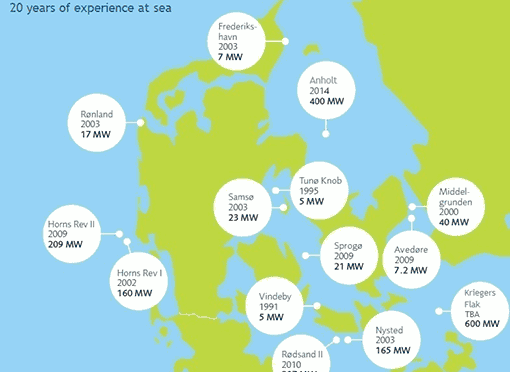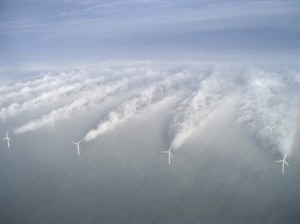Denmark has been long been a pioneer in wind power, having installed its first wind turbines in the mid-1970s when oil shocks sent the import-dependent nation on a quest for energy security.
Thirty-seven years later, the country has set a new world record for wind production by getting 39.1 percent of its overall electricity from wind in 2014. This puts the Northern European nation well on track to meet its 2020 goal of getting 50 percent of its power from renewables.
The news of Denmark’s feat adds to the national records the U.K. and Germany set for 2014 and further establishes Europe as a leader in the wind power industry. This is especially true when it comes to offshore resources, as countries like Scotland, England, and Denmark build out their offshore wind farms. Wind generated enough electricity to power just over 25 percent of U.K. homes in 2014 — a 15 percent increase from 2013. In December, Germany generated more wind power, 8.9 terawatt-hours, than in any previous month.
A big source of the surge of Denmark’s wind production this year came from the addition of around 100 new offshore wind turbines. In January of 2014, the peninsular country got just over 61 percent of its power from wind. This is more than three times the overall production of 10 years ago, when wind only made up 18.8 percent of the energy supply. The country has a long-term goal of being fossil fuel-free by 2050.
“We have set a one-of-a-kind world record,” said Denmark’s Climate and Energy Minister Rasmus Helveg Petersen. “And it shows that we can reach our ultimate goal, namely to stop global warming.”
While Peterson may be getting ahead of himself with his enthusiastic statements — as it would be impossible for Denmark to stop global warming even if the small country had zero emissions — Denmark is nonetheless charting one of the most ambitious national paths towards greenhouse gas mitigation. The government has a goal of reducing GHGs by 40 percent by 2020 compared to 1990. According to the government, they are on track to reduce emissions by 37 percent.
Through expanding wind power and converting more heat pumps and power plants to use biomass, the Danish Ministry of Climate, Energy and Building believes that the country could get 71 percent of its electricity from renewable sources by 2020. In 2000, that share was just 16 percent. Electricity only makes up around a tenth of Denmark’s total energy usage, which is overall still dominated by fossil fuels. This ratio is steadily shifting, especially when it comes to coal, use of which is supposed to drop by about 57 percent from 2012 to 2020.
According to Aalborg University professor of energy planning Brian Vad Mathiesen, in order to really make a dent in the country’s overall energy profile Denmark needs to transition it’s heat pumps from using fossil fuels to using wind.
“It is moving too slowly with getting the heat pumps into our heating systems and thus integrated into the energy and heat sector,” he said. “That becomes more and more pressing as the amount of wind energy increases.”
In fact, Denmark could soon suffer from an overabundance of wind energy. According to Danish Energy, an umbrella organization representing energy companies, high production levels could cause prices to deflate which could lead energy companies to charge customers more to account for the cost gap — or even remove the incentive for the power companies to stay in business. For now, when wind generates too much power for Denmark’s grid the excess is sold to neighboring countries.
“If we keep putting up wind turbines, we will keep having low prices in the market, which means consumers would have to pay a high price related to their energy consumption. We would have an energy market with large price volatility where some times the price would deflate and at other times, the price would be sky high. it would be an unstable system,” Lars Aagaard, the director for Danish Energy said.
Aagaard said that by electrifying the heating and transport sectors, energy companies would have an outlet for any excess wind power. New forms of renewable energy storage could also aid in addressing the problem.
Denmark is also benefiting economically from its early investment in wind as the country has become a leading wind power manufacturer with major firms like Vestas and Siemens Wind Power based there. Currently around nine out of every 10 offshore turbines installed globally are made in Denmark.
http://thinkprogress.org



